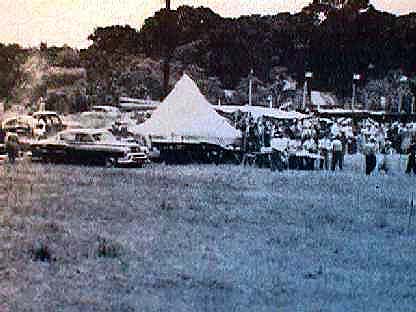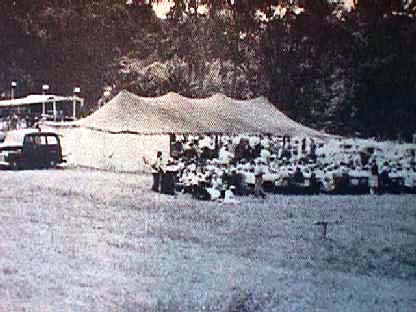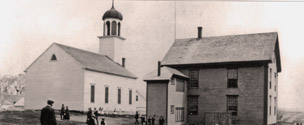Barbecue
Chickens and Community Pride
Note: This story is an attempt to chronicle the development of our town's unique Barbecues. To properly tell this story, we'd have to list half the people in town, and the odds are we'd still forget someone. Well, we decided to stay away from a credit riddled story, and instead, offer everyone an account of incidents, big and little, that made the last 25 years in Bowdoinham so special. The barbecues really are special. They are the fruits of a whole town's labor and our town's a whole lot better because of them.

 Cars and people crowded into Cleve Curtis' field for the first Bowdoinham Barbecue, July 4th, 1954.
Cars and people crowded into Cleve Curtis' field for the first Bowdoinham Barbecue, July 4th, 1954.
Bowdoinham's July barbecues were born of necessity. This town needed desperately to enlarge and update its school system, and there was a group of townspeople adventuresome enough, or courageous enough, to try to do it without turning to higher taxes.
The year was 1954, and their answer was a July 4th chicken barbecue. A committee of ten marshalled a host of volunteer townspeople, and when the day was done, more than $1,100 sat in a bank, awaiting construction of the new school. But there was something else, something special. A seed had been set, and it would prosper. The barbecues would grow and expand over the next 25 years, and collectively, raise nearly $50,000 to help buy our town its school house, a fire truck, recreational lands and other projects. That pioneer barbecue was hosted by chef Waldo Chick of Kennebunk, and sold for a modest "buck and a half." Then as now, there was a barbecued chicken half, a salad, potato chips, a brownie, and a small bottle of milk from Millay's Dairy.
Tents marked the site of the proposed school, and crowds of local folks clustered around an architect's sketch of the four-room building, and most of them nodded approval. The barbecue was a sell-out, and about the only complaint an out-of-stater claimed that dust from the nearby dirt road did little for the flavor of his chicken dinner.
NEW SCHOOL
Hot on the heels of that first success, a committee of thirteen &emdash; Linwood Hackett, Marion Fides, Dan Christie, Spear Sedgley, Karl Hatch, Elmer Dodge, Andrew Peterson, George Millay, Ella Curtis and Helen Dudley for the town, Linwood Rideout, Malcolm Jewell and Winfield Lowell for the school board &emdash;began their drive for the new school.
Saturday work bees became weekly occasions. Chain saws and axes ripped through woodlots of donated standing timbers. They used the Tourtelotte brothers' horses to twitch out the logs, and trucked them to Hackett's mill where they were sawed and planed.
More weekends passed and the school began to take shape. Volunteers mixed and poured the cement for its floor and foundation, then they framed the structure and boarded it in. When it was time for the second annual barbecue in 1955, fairgoers had the roughed in shell of the new school as insurance against possible rain.
An estimated 1,200 people attended that second barbecue. It was billed as a field day, and promoters had added a street parade, a midway and a baby carriage decorating contest. 1955 was also the year that George Millay tried his experiment with raising chickens. The committee hoped to save a little money by home growing their dinners on the roof, so Millay agreed to raise 600 birds donated by Coleman's Farms in Brunswick. Millay guesses his effort saved the committee about $300, but the project was never repeated.
The smell of fresh-sawed lumber mingled with scents from the charcoal pit that year. Folks ate at wooden tables in two of the rough-framed classrooms, played Beano in a third, and looked at exhibits by local industries in the fourth.
The midway had grab bag booth and novelties. The Boy Scouts operated a chocolate milk bar, and the high school kids sold hot dogs.
Townspeople realized their dream for a school in the fall of 1955. The fall term opened in the nearly finished school. Head carpenter Stanley Bruce, who was the only full-time employee on the project, did the finish work with delighted students running around his feet.
It was the first time in the history of Bowdoinham that no one-roomed schools were used to educate the town's children (Bishop's and Ridge schools closed that year). Secondly, it was the first time in the town's history that the town employed one teacher for each grade.
The highlight of the 1956 barbecue was the formal dedication of the new school. Bowdoin College President James "Spike" Coles stood on a platform in front of the sparkling school, and he praised Bowdoinham for its efforts.
The four-classroom, 58 x 115 foot building had an established construction cost of $90,000, but Bowdoinham had built it for $52,000. Donated labor and materials made the difference. Of the $52,000 cost, $12,000 came in cash donated by local people and industry. The town raised $10,000 through taxation, borrowed the rest with the understanding that the barbecues would continue and try to repay the debt.
In recognition for the thousands of volunteer hours that went into the building, the school was named Bowdoinham Community School. The Portland Press Herald summed up the project with the following: "If there ever was a true community project, this new elementary school in Bowdoinham is it."
The local Knights of Pythias lodge opened its benefit auction in 1956 and one of the items on the block was a ton of Sagadahoc fertilizer. The effort added hundreds of dollars to the $1,100 total raised that year, and the auction was guaranteed an annual spot at the annual barbecue.
In 1956, grocer Delmar Curtis felt competent enough to take over the cooking from Mr. Chick, and the barbecue became a purely local effort.
A midnight dance at George Millay's new "Round top" barn was the biggest new feature of the 1957 barbecue.
OLD HOME WEEKEND
Millay directed the 1958 barbecue, and it was a year to remember. It was called Bowdoinham's first "old Home" celebration in 50 years, and stretched over a long, holiday weekend. In that year Bowdoinham's first Miss Slick Chick was crowned, lobster suppers were sold at a profit for $1.50 a head, and Bowdoinham's skeet team defeated Richmond's team in a contest behind the new school.
Nine girls dressed in below-the-knee skirts, ruffled blouses and bobby socks entered the competition for the first Miss Slick Chick title. An early set of rules suggested the winner "must be a wholesome sort of girl, popular, and possessing a little talent."
Sandra Benner, Janice Humphrey, Linnea Lammers, Elaine Merrill and Mary Temple entered from Bowdoinham, Janice Pinkham and Anne Stansbury from Richmond, Beverley Cornish from Bowdoin and Penny Harris from Brunswick, but when the pageantry was over, the crown belonged to Elaine Merrill.
1958 was the year Merrymeeting Grange offered its sell-out version of the play "Hessie of the Hills" at the town hall, and Jimmy Millay won the pie eating contest by finishing his spilled blueberry pie where it laid on the floor.
Ella Curtis and Helen Robinson (Hunter) exhibited pictures of Coombs School graduates from 1899 to 1945, and 20 kilted bagpipers from Lewiston led the big parade.
The 1959 barbecue featured the first ox pulling contest in Bowdoinham. There were nine yoke in that first meet which was organized by Adelbert Temple and Horace Lancaster. Their drivers competed for $50 in prize money.
WMMS in Bath offered a live broadcast at the barbecue that year, and the S.D. Warren Company Band of Westbrook was a feature of the parade.
Robert Blake chaired the 1960 barbecue. Fair-goers watched as state officials helped dedicate Bowdoinham's new municipal water system, and applauded when they were told that the last note on the Bowdoinham Community School had been paid off.
Local bakers Lou Climo and Carl Lindsay agreed to cook the 1500 brownies needed for the 1960 barbecue. It wasn't a small project. It takes 25 pounds of flour, 25 dozen eggs, 63 pounds of sugar 16 pounds of butter, 16 pounds of chocolate, a pound and a half of baking powder, 37 pounds of walnuts, salt and vanilla to taste, to make 1,500 brownies.
The 1961 barbecue brought new interest in the ox pulling events. Bowdoinham's Pioneer Steer Club, the first 4-H steer club in the country, offered a lively exhibition, and spectators sat on the new set of bleachers erected by volunteers.
As usual, the weather over this fourth in Bowdoinham was perfect. Barbecue planners started to gloat that "it never rains in Bowdoin ham on the fourth."
One additional footnote. We find 1961 is the first year in which townspeople questioned the necessity of retaining the annual celebrations.
That year the skeptics were calmed with the information that Bowdoinham was 199 years old, and the vote was made to continue the barbecues, and make 1962 special.
BOWDOINHAM'S BICENTENNIAL
1962 certainly did end up special. The town was decked in bunting for a five-day celebration, and special activities included a fireman's muster, a beard-growing contest, fireworks and historical displays. The week was hectic with activity, and in summary, looked something like this: July 4, the chicken barbecue, Governor John Reed's reception, ox pulling contests, auctions, and bicentennial queen elected. July 5: mock 1912 town meeting, a Down East clambake, square dance and a special program titled "This Is Your Life Bowdoinham, 1762-1962.
Friday, July 6, was reunion day. There was an old-fashioned box social, a centennial play, class reunions for Bowdoinham's high school, a kid's parade and old-fashioned kid's games.
Saturday, July 7, was the day of the firemen Bowdoinham's old Phenix and Water Witch hand tubs were features of the firemen's muster and ladies of the local auxiliary were hostesses of the potluck supper. Then there was an antique car parade, a reception for Senator Ed Muskie, and a shaving contest for all the Brothers of the Brush who had grown beards for the bicentennial. A record 1,500 chicken halves were sold that year, and at least 10,000 visitors came to town to take part in the gala birthday party.
The 1963 barbecue was another good one. Governor Reed flew onto the school grounds in a National Guard helicopter, and Senator Muskie motored back for the chicken dinner in his family car. 1,100 chicken dinners were sold that year, along with 500 pounds of lobster, 200 pounds of hamburg . . . and barrels of popcorn.
In 1964, tragedy struck the barbecue. First of all, there was a half-hour rain squall that soaked the day's activities and profits. Then there was the pony. It was a four-year-old pony, and the barbecue committee planned to use it for pony rides and then offer it in a raffle.
But it wasn't to be. A Times Record report tells the story: Little Mike Temple had the frisky animal out for exercise when the boy lost his footing and, rather than be dragged over some stones, he let go of the rope . . . The pony dashed into the road and was promptly hit . . . and had to be destroyed."
Bowdoinham was talking about joining a school administrative district in 1965, and once again, barbecue organizers talked about ending the annual. There was a public meeting May 13 to vote, and the decision was to go on. That year was a sellout for chicken dinners, and Patricia Boda won the Miss Bowdoinham crown.
There was an editorial complaint in the Times Record after the 1966 barbecue. It seems the fireworks at Bowdoinham had been advertised for 10 p.m., but someone fired them off at 9:30. "There were many carloads of disappointed parents and children," the editor said "some may remember their vain trip for a long time."
The 1968 celebration got off to a roaring start. About midnight of the third, some of the local boys filled the cannon on the common with gunpowder and toilet paper and touched it off. Windows were shattered in the town manager's office, and they picked waste paper off the roof of the Gray estate.
The fireworks were on time and brought out huge crowds that year. Chicken dinners sold out at 1,300, and Julia Hunton won the Miss Bowdoinham title.
George Millay came back to direct the 1969 barbecue, and when it was over, it was termed "a success in every sense of the word." There were lots of new attractions, including an old MacDonald ' s Farm, an art show, and some major amusement rides.
James Read finally located and signed a ferris wheel operator one week before the fourth, and it was a sellout year for barbecue chef Raymond Blodgett&emdash;1,600 halves sold in just three hours.
For the first year, funds from the barbecue weren't quite earmarked for school construction. The committee voted to spend its profit to build a basketball-tennis court adjacent to the school.
The 1970 barbecue opened Thursday night with the talent show for the Miss Bowdoinham beauty contest. James Read was chairman that year, and he made the Midway one to remember. A ferris wheel again dominated the area, and amusements stretched from the school to the ox pulling pits.
There was an open-air dance on the newly paved tennis court, and committee members agreed that their profits should go to help fence in the recreation area.
Ralph Purington's air show was a feature of the 1971 barbecue. A Navy parachute team made a drop over the barbecue grounds, and the aerial antics of Bob Weymouth, the flying farmer, were enough to turn stomachs on the ground.
1971 was the year that barbecue planners turned their efforts to a new fire truck. Community members responded with their customary enthusiasm, and when it was over at least $3,000 was ready to help pay off the fire truck note.
Bowdoinham's new fire truck led the half-mile long parade at the 1972 barbecue. The $22,000 vehicle would be paid off in two years, about $7,000 coming from the barbecue committee, the rest raised by the town or returned wages donated by our volunteer firemen.
The Historical Society art show achieved a cultural high for the barbecues in 1972, exhibiting five N.C. Wyeth paintings valued at more than $30,000. The works were completed in 1938 to accompany Kenneth Robert's best seller Trending Into Maine. The paintings were loaned by the Depositor's Trust Company.
Old MacDonald's Farm moved into a tent that year. It was Annie Hawthorne's usually fine menagerie of domestic animals &emdash; a pony and colt, dog and pups, a bottle-fed lamb, chicks, geese and finally, "Johnny the Jackass."
David Berry and 1975 brought drastic changes to the style, and operation, of the Bowdoinham Barbecue. It was a two-day affair, and the second day was chiefly musical. Mechanical rides were out, small-town fun was in.
That was the year of the first Bowdoinham fiddler's convention, the first farmer's market, and the last Miss Bowdoinham pageant. There were 26 entries in the parade, and 40 yoke of oxen in the pulling contest. They sold out 1,200 chicken halves, sold the last plate of Arthur Veno's special spaghetti, and ran out of sodas, and just about all the fruit for sale in the farmers' market. When it was all over, profits stood at a record high, nearly $4,000.
In 1976, America celebrated its 200th birthday, and Bowdoinham celebrated its 23rd barbecue. The Historical Society designed and raffled a beautiful quilt, and everyone in town who worked on it was delighted to have a Bowdoinham family, the Robert Knights, take it home.
The art show was cancelled for the year because of construction inside the school, but the fiddling contest was a sellout, and so was the 1,500 chicken halves. Profit for the year amounted to nearly $4,000 and was spent to help purchase and help grade a community recreation area adjacent to the community school.
Last year the barbecue moved in still another direction, sponsoring a series of contra dances at the town hall. Hartley Douglass cooked and sold 1,000 chicken halves, and the two-day event was ended with several hundred people dancing around a bonfire.
In 1977, the barbecue committee voted to divide its profits four ways, the first $1,000 to be spent on the town's recreation field beside the school: the remainder being divided between the Richmond Area Health Center, town hall renovation, Coombs School rehabilitation, and local recreation projects. It was another good year, just like all the rest.
Bowdoinham Advertiser, July 1978
Frank Connors, Editor
